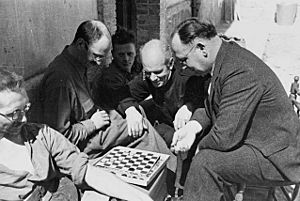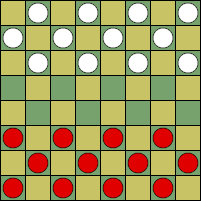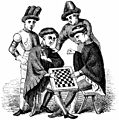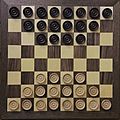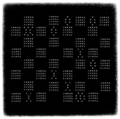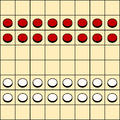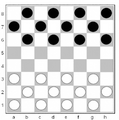Checkers facts for kids
Checkers (also called draughts) is a fun board game played by two people. It's a bit like chess, but with simpler rules. The main goal is to capture all your opponent's pieces. You do this by "jumping" over them.
In the United States, people usually call the game "checkers." But in British English and many other English-speaking countries, it's known as "draughts." The rules for different types of checkers games and their championships are managed by the World Draughts Federation.
Contents
History of Checkers
Checkers has a long history. We know for sure that people were playing it in France by the 12th century. Some old checkerboards have been found, but historians aren't sure if the game was played even earlier.
There are two main types of checkers played today:
- The Anglo-American version came from France. It's played on an 8x8 board, like a chess board. Each player starts with 12 pieces.
- The Continental version (also called Polish draughts) is played on a larger 10x10 board. Each player starts with 20 pieces. This version is popular in many parts of Europe.
Many countries also have their own special ways to play checkers!
How to Play Checkers
Most checkers games are played by two players. They sit at opposite sides of the board. One player uses dark pieces, and the other uses light pieces. Players take turns moving their pieces. You move your pieces diagonally from one square to another.
When you jump over an opponent's piece, you get to take that piece off the board. If you have a chance to jump and capture a piece, you must do it!
English Draughts Rules
English draughts is the version often called "checkers" in the US. It's played on an 8x8 chess board. Only the dark squares are used for playing.
Pieces and Setup
- Pieces: The pieces are flat and round. They are called "men." They can be dark and light, or red and white. The two sides are known as Black and White. Black always moves first.
- Starting Position: Each player begins with 12 pieces. These pieces are placed on the three rows closest to their own side of the board. The row closest to each player is sometimes called the "Double Piece Row."
Moving Pieces
- Basic Moves: Single pieces (the starting pieces) can only move diagonally forward. They cannot move backward.
- How to Move:
* A piece can move forward, diagonally, to the very next empty dark square. * If your piece, an opponent's piece, and an empty square are lined up, you must "jump" the opponent's piece. You jump over their piece onto the empty square and remove their piece from the board.
- Multiple Jumps: Sometimes, you can make several jumps in one turn with a single piece. This happens if each jump leads directly into another jump in a straight line.
- Choosing Jumps: If you have a choice of which opponent piece to jump, you can pick which one to capture.
- Changing Your Mind: If you put your hand on a piece to move it, you can still change your mind and move a different piece, as long as you haven't lifted your hand off the first piece.
Double Pieces (Kings)
- When one of your pieces reaches the last row on your opponent's side of the board (the "Double Piece Row"), it becomes a "double piece." This is also called a "king."
- To show it's a king, you put another plain piece on top of it.
- A king is special because it can move both forwards and backwards diagonally.
- A piece that just became a king cannot move out of the double piece row until your next turn.
How the Game Ends
The game ends when:
- A player loses all of their pieces. That player loses the game.
- A player cannot make any legal moves. That player loses the game.
- If both players have the same number of pieces, the player with more double pieces (kings) wins.
- If both players have an equal number of pieces and the same number of double pieces, the game is a draw (a tie).
Images for kids
-
Christopher Strachey's checkers (1952) the first video game
See also
 In Spanish: Damas para niños
In Spanish: Damas para niños


